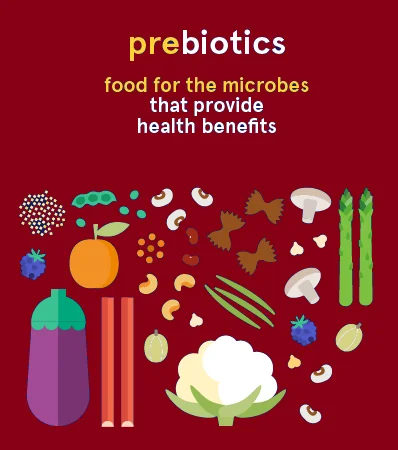What Are Prebiotics and What Do They Do?
The microorganisms residing in the human gastrointestinal system—commonly referred to as the gut microbiota—ensure that no ingested nutrient is wasted. These beneficial microbes are responsible for decomposing and processing dietary substances, thereby enhancing immune function and assisting in the management of inflammatory responses. However, what supports the survival and efficiency of these valuable organisms? And how can their biological activity be optimized for improved health outcomes? The response lies in the intake of prebiotics.
What Do Prebiotics Do?
To comprehend the function of prebiotics, it is first essential to distinguish them from probiotics, as the two terms are frequently interchanged.
Probiotics refer to live microbial strains originally derived from the human intestinal tract, which exhibit beneficial physiological effects when consumed in sufficient quantities. These live cultures are commonly present in nutritional supplements and fermented consumables such as kombucha, yogurt, and tempeh.
For an organism to qualify as a probiotic, it must withstand exposure to gastric acid and bile salts upon ingestion, enabling it to reach the colon where it interacts with the pre-existing resident microbiota. Upon arrival, it must be capable of sustaining itself within that environment. A greater diversity of these beneficial microorganisms increases their functional potential within the host.
Prebiotics function as a nutritional substrate for the microorganisms inhabiting the gastrointestinal tract, and they must resist the digestive process to reach the colon intact. Upon arrival, these microbial communities utilize prebiotics through metabolic and fermentative activity to sustain themselves. This process of biochemical conversion is highly beneficial for gastrointestinal well-being, as it generates a variety of secondary compounds that contribute to multiple physiological advantages.
During the degradation of prebiotics by gut microorganisms, distinct short-chain fatty acids (SCFAs) are synthesized based on the specific type of prebiotic ingested. These SCFAs perform several important roles, including supplying energy to colonic epithelial cells, promoting mucus secretion, and supporting inflammatory regulation and immune function.
Benefits of Prebiotics
The advantages associated with prebiotic intake are both extensive and diverse. Although ongoing scientific investigations continue to examine the precise mechanisms by which nutritional substrates for the gut microbiota exert their effects, several notable outcomes have already been identified:
- Support the regulation of intestinal transit and bowel consistency.
- Facilitate the synthesis of neurotransmitters that travel bidirectionally between the gastrointestinal system and the central nervous system, influencing mood regulation and related physiological processes.
- Promote the endogenous production of hormones involved in the modulation of appetite, satiety, and other essential metabolic functions.
- Contribute to bone mineralization and enhance the absorption of calcium and phosphorus, thereby improving overall bone density.
- Strengthen immune function, enhancing the body’s ability to defend against pathogens.
- Augment the body’s anti-inflammatory response, supporting systemic health.
- Elevate the population of beneficial bacterial strains while reducing pathogenic species associated with disease development.
Prebiotic Foods
Prebiotic-rich foods are typically abundant in specific forms of dietary fiber, particularly fermentable soluble fiber. The method of preparation significantly influences the prebiotic availability within these foods, as thermal and mechanical processing can alter their chemical composition. While numerous categories of prebiotics exist, three of the most notable are resistant starches, inulin, and pectin.

Resistant Starches
Analogous to fiber in function, resistant starches evade enzymatic digestion and reach the colon intact, where they serve as a primary substrate for the resident microbial population. The fermentation of resistant starches commonly yields butyrate, a short-chain fatty acid that supports water and electrolyte absorption, bolsters immune system performance, and contributes to anti-inflammatory activity.
Take potatoes as an example. The resistant starch content is significantly reduced when they are baked. However, when potatoes are boiled and subsequently cooled, a white, starchy film forms—this visible layer represents the resistant starch beneficial to gut microbiota. Common dietary sources of resistant starches include:
- Boiled and chilled potatoes
- Green bananas
- Barley
- Oats
- Rice
- Beans
- Legumes
Inulin
Inulin is a prebiotic fiber naturally occurring in numerous plant species. This essential compound promotes prolonged satiety, aiding in appetite regulation and preventing excessive food intake, while also facilitating regular bowel movements. Additionally, inulin has been shown to reduce low-density lipoprotein (LDL) cholesterol, assist in blood glucose stabilization, and enhance the growth and persistence of beneficial gut bacteria. Furthermore, it may contribute to a reduced risk of colorectal malignancy. Although inulin is available in supplemental forms such as gummies, tablets, capsules, and powders, foods containing natural inulin-rich often offer additional nutritional benefits through their antioxidant properties and micronutrient content. Examples of inulin-rich foods include:
- Asparagus
- Burdock root
- Chicory root
- Dandelion greens
- Garlic
- Jerusalem artichokes
- Leeks
- Onions
- Soybeans
- Wild yams
Pectin
Pectin is predominantly found in various fruits, with particularly high concentrations located in the pulp of raw apples. As a gel-forming starch, pectin is widely utilized in the preparation of preserves, including jams and jellies. Beyond its culinary function, pectin exhibits both antioxidant and anti-tumor characteristics. It may also strengthen the epithelial integrity of intestinal lining cells, reduce the likelihood of pathogenic bacterial colonization, and promote greater microbial diversity within the gastrointestinal environment. However, additional human-based research is required to establish a broader understanding of its full range of potential health effects. Foods naturally rich in pectin include:
- Apples
- Apricots
- Carrots
- Green beans
- Peaches
- Raspberries
- Tomatoes
- Potatoes
When to Take Prebiotics (and When You Shouldn’t)
It is important not to abruptly increase prebiotic intake. A sudden and excessive introduction can overstimulate the gut microbiota, leading to uncomfortable side effects such as bloating and excessive gas. Therefore, prebiotics should be gradually incorporated into the diet to allow for a controlled microbial response and to prevent adverse gastrointestinal symptoms.
Given that the body functions in alignment with a circadian rhythm, gut microorganisms exhibit higher levels of metabolic activity during the day. Consequently, it is advisable to avoid consuming prebiotics in the late evening, as this may disrupt natural digestive patterns.
Individuals experiencing gastrointestinal disorders such as irritable bowel syndrome (IBS) may encounter difficulty digesting specific prebiotics, particularly those found in stone fruits including peaches, mangos, and cherries.
